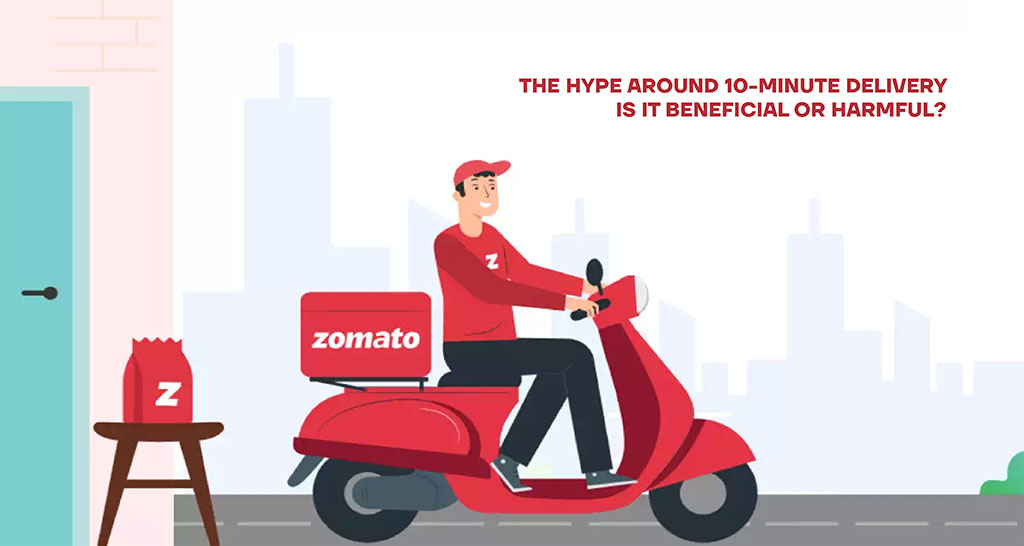The 10-minute delivery phenomenon demonstrates the notable shift in retail operations and consumer preference. The instant commerce industry is thriving rapidly, delivering everything from groceries to fresh meals within 10 minutes. The new-age grocery startups kindled the quick delivery culture, and later the traditional industry giants like Amazon and Tata Group empowered the realm. It is no secret that this instant delivery of prepared food and other things has simplified daily life. But equally, it raises serious questions on health and safety.
The New Buzzword: 10-minute Delivery in Detail
The rapid growth in quick commerce showcases a fundamental shift in consumer behavior and expectations. In this fast-moving age, people want to get instantly and conveniently. Today, time has become the biggest commodity that people are not willing to waste on less valuable things. The emerging e-commerce ventures are actively turning this wish into reality.
The instant delivery concept was introduced in the pandemic era; it has evolved into a mainstream service now. The notable development of these ventures is quite evident in these companies’ performance. Quick Commerce currently represents more than half of its food delivery business and is progressing six times faster. The rapid market growth has attracted both prominent players and new business ventures.
Quick, Convenient, and Effective: The Primary Advantages
The quick delivery services mainly the growth shopping is the outcome of the pandemic. Later, the process was pulled into a mainstream business. As per the Wall Street Journal, the grocery market registered a figure of $2 trillion at the global level. This figure is a significant factor that has inspired numerous entrepreneurs to grow their ventures. Here are some key benefits:
Quickness
The same-day delivery concept caught the attention of consumers from across the world because they broke the tradition of receiving the ordered item after a few days. eCommerce platforms tried their swift network to get things done in a much shorter time after assuring the availability of the resources a buyer needs. The quick commerce 10-minute delivery app is based on the hyperlocal model that arranges the nearest resource to the picking and delivery spots as quickly as possible.
Social and Labor Implications
The quick delivery revolution has caused a difficult web of social and labor implications. It has generated numerous career opportunities to recover from the decreasing career opportunities post-pandemic. The serious concerns related to the safety of employees cause an increasing range of road accidents. Further, the commerce delivery landscape struggles with ensuring minimum payout, and collective bargaining rights remain a distant goal for many workers. Furthermore, the disruption in the traditional retail supply chains has created tension within the broader retail ecosystem.
In terms of working conditions and grievance handling, as improved, the fair compensation packages and work rights are still not defined clearly and include a lot of gaps.
The Hidden Costs of Convenience: Disadvantages
Despite so many benefits of the 10-minute food delivery services, doctors and medical experts are concerned about the health implications of these delivery services. The basic question is: How can someone cook food and deliver it so quickly without compromising quality and nutrition?
The answer is surely the ultra-processed foods (UPFs), which are the backbone of quick-delivery meals. As per the latest studies, the regular consumption of UPFs increases cancer risk by 12% and cardiovascular disease risk by 10%. Some more health-related and other issues:
Health Concerns
Consuming these foods also causes the obesity epidemic, and the high glycemic index of these processed foods leads to dangerous blood sugar spikes that ultimately increase the risk of diabetes. The presence of elevated levels of trans fats in these quick-delivery meals has been directly connected to an increased number of heart diseases.
The food preparation process generally follows the pattern, including pre-cooking, freezing, microwaving, and delivery. This process completely focuses on speed, with no consideration of nutrition or the long-term health implications for regular consumers.
The excessive use of preservatives and stabilizers is another major concern. These ingredients are widely used to ensure long shelf life but also include significant health risks. To ensure instant delivery, foods are prepared beforehand and delivered with a quick heating. The process of freezing and reheating causes nutrient loss in the food.
Overall, the convenience of quick food delivery encourages consumers to opt for calorie-dense and nutrient-poor options, which can have long-term health implications.
Besides, as consumers are becoming dependent on food delivery apps, there is an increasing need for transparency in food preparation practices and nutritional integrity. People need to be aware and alert that convenience should not come at the cost of our health.
Safety of Delivery Boys
These instant solutions have made things smoother for common people, but the executives sitting at the strategy table can not completely avoid the practical risks on the roads. Since there is no time restriction, the delivery boys are rash and hurry on the roads; just manage the effect when the time stipulation comes into play. The roads are the biggest speed breakers in the quick e-commerce business.
While the companies have specifications and policies of nondisclosure of the deadline, penalizing the deliveries, and providing insurance, delivery boys work under the stress of completing the targets that multiply while coming top to bottom in the hierarchy.
Bottom Line
The 10-minute e-commerce market is flourishing rapidly, but we cannot ignore the serious health concerns and other challenges. Aspiring entrepreneurs and business leaders looking to begin their business in this space should be focused on balancing speed with sustainability, convenience with health, and growth with profitability. It’s no piece of cake to balance.
Considering the advantages and disadvantages of 10-minute delivery, we need to find a middle ground— not everything needs to be delivered in 10 minutes. As the market grows, we will be writing a more nuanced approach where delivery times are fastened according to the product, consumer need, and health considerations instead of just focusing on the speed at any cost. Otherwise, we will be left with an endless arms (or foot) race of delivery riders racing to your home, packages in tow.







